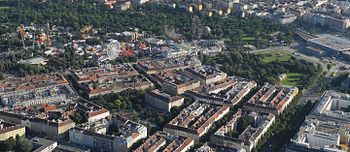Stuwerviertel
The Stuwerviertel is a district of Leopoldstadt , Vienna's 2nd district .
geography
The Stuwerviertel is located between the Praterstern or the adjoining park called Venediger Au and the (north) east running Danube and has the shape of a triangle. It is bounded in the south by Exhibition Street and the Prater behind it , in the northwest by Lassallestrasse and the Nordbahnviertel behind it , an urban development area, and in the northeast by Engerthstrasse and Handelskai on the Danube.
At the beginning of the odd side of the exhibition street (No. 3–7) at the beginning of the Stuwerstraße (No. 1–5 and No. 4–10), as well as towards the Venediger Au (No. 2–7) there is a closed ensemble from the late historical perspective -secessionist apartment buildings, mostly with front gardens, which are defined by the city of Vienna as a protection zone.
history
Originally, part of today's Stuwerviertel was due to its location on the then still unregulated Danube floodplain with meadows, wooded areas and frequent floods. In 1766 Joseph II opened the Vienna Prater, which had previously been reserved for the imperial court, to the public. Partly in the area of today's Stuwerviertel, the Wurstelprater or Volksprater was created as an amusement park. The quarter got its name (only in the last decades of the 20th century) from Johann Georg Stuwer , who organized popular artificial fireworks in this area from 1774 . In 1876, his great-grandson Anton Stuwer set off the last Stuwer fireworks display ; In 1898 the Stuwerstraße was named here.
During the world exhibition in 1873 , the world exhibition railway of the Kaiser-Ferdinands-Nordbahn led through the still undeveloped area to the world exhibition station. After the Danube regulation was completed in 1875, development of the site began; the first houses were built along the exhibition street in the 1880s. At the beginning of the 20th century, a large part of the Stuwerviertel was already built; many of these Wilhelminian style houses still exist today.
The north-eastern part of the Stuwerviertel (then: Feuerwerkmais ) was planned as the new “Donaustadt” district at the end of the 19th century. Since the name was apparently not used by the population and other Grätzlnames were formed instead, it was used in 1954 for the new 22nd district. In the name of the parish Donaustadt (parish church is the Franz-von-Assisi-Kirche ) this name is still preserved.
Between Ennsgasse, Vorgartenstrasse, Jungstrasse and Wohlmutstrasse, in the middle of the Stuwerviertel, there was a large reserve garden of the Vienna city administration since 1897 . It was moved to the 22nd district in several stages from 1957 and is now called the Hirschstetten Flower Gardens . The front garden market, several large community buildings (urban residential buildings) and the Sigmund-Freud-Gymnasium, which opened here in 1967 on Wohlmutstrasse, were built on the vacated area .
There are other schools in school buildings built around a hundred years ago: the municipal elementary school on Wolfgang-Schmälzl-Gasse, the municipal secondary school on Max-Winter-Platz and the municipal secondary school on the corner of Feuerbachstrasse and Jungstrasse.
On the north-eastern edge of the district, the Engerthstrasse steam power station was mostly operated by the city administration from 1890 to 1966 . A municipal residential complex was built on his property at Engerthstrasse 189–191 in 1976–1978 . On the eastern edge of the quarter near the exhibition street, at the Vorgartenstraße 223, 1896-2005 was the Archduke Wilhelm barracks . After it was demolished, houses were also built here.
In 1982, on the northern edge of the Stuwerviertel, in the course of Lassallestrasse, the Vorgartenstrasse underground station on the U1 line was opened. In 2008, the Messe-Prater underground station on the U2 line went into operation on the southern edge of the district in the course of the exhibition street. In connection with this, the tram lines previously operated on the edges of the district disappeared.
Since the opening of the WU campus on the other side of the exhibition street in 2013, the district has been changing in a rapid manner that is described as gentrification .
prostitution
Due to its proximity to Europe's largest amusement park, a red light scene emerged at the beginning of the 20th century , which has developed into one of the largest in Vienna. There are room rentals for street prostitutes , bars, brothels and sex shops.
The Stuwerviertel has therefore repeatedly been associated with questions of security and order in the public consciousness. Street prostitution in residential areas, including the Stuwerviertel, has been prohibited in Vienna since 2011.
Individual evidence
- ↑ Entry on Stuwer, fireworks family in the Austria Forum (in the AEIOU Austria Lexicon )
- ^ Meyers Konversationslexikon 1885-1892
- ^ Wiener Zeitung : And Vienna grew across the Danube ( Memento from May 26, 2009 in the Internet Archive )
- ↑ WU new: The Stuwerviertel is waking up. In: DiePresse.com. October 1, 2013, accessed August 10, 2019 .
Web links
Coordinates: 48 ° 13 ' N , 16 ° 24' E





